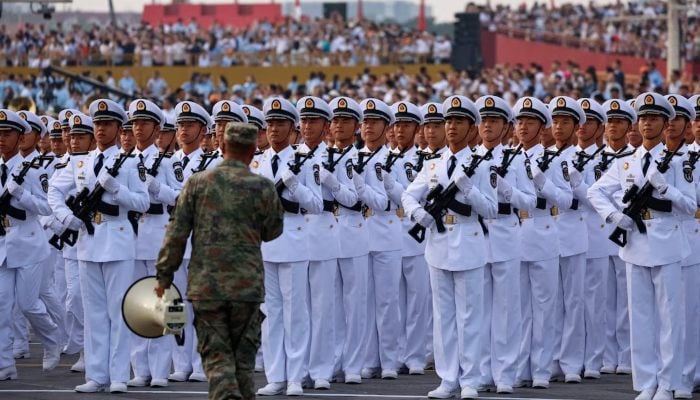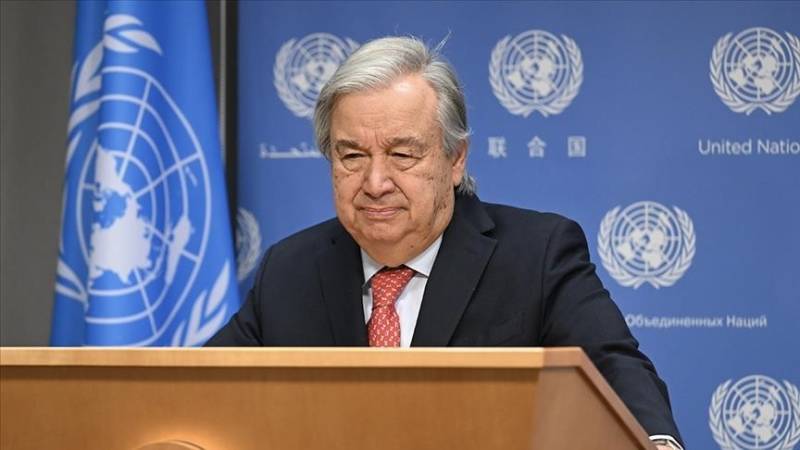- New Policy Signals Support for China Banks’ Unsecured Household Lending Fitch Ratings
- Subsidized loans eye stimulating consumption China Daily
- Experts expect new loan interest subsidy to boost consumption bastillepost.com
- China Rolls Out Subsidized Consumer Loans to Boost Spending Caixin Global
- Banks, consumers welcome interest subsidies for personal consumption loans bastillepost.com
Blog
-
New Policy Signals Support for China Banks’ Unsecured Household Lending – Fitch Ratings
-

Trump laments Xi should’ve mentioned US in ‘impressive’ WWII ceremony
US President Donald Trump on Wednesday praised China’s “beautiful ceremony” commemorating the end of World War II but said it should have given greater emphasis to the role of the United States in Japan’s defeat.
“I thought it was a beautiful ceremony. I thought it was very, very impressive,” Trump told reporters in the Oval Office. His remarks came just hours after he suggested on social media that the gathering of foreign leaders in Beijing could be part of a conspiracy against Washington.
“I watched the speech last night. President Xi is a friend of mine, but I thought that the United States should have been mentioned last night during that speech, because we helped China very, very much.”
The Chinese embassy in Washington did not immediately respond to a request for comment.
Chinese President Xi Jinping has made the 80th anniversary of the war’s end a major showcase for his government and its close ties with countries at odds with Washington.
Flanked by Russia’s Vladimir Putin and North Korea’s Kim Jong Un, Xi spoke before a crowd of more than 50,000 spectators at Tiananmen Square. He surveyed a parade of goose-stepping troops and cutting-edge military equipment aimed at deterring would-be adversaries including the United States.
Japan’s invasion of China in 1937 was a major escalation in fighting that would lead to World War Two, and Japan’s surrender in 1945 marked the end of the conflict. The US joined the war in 1941, aiding Chinese forces fighting the Japanese military and playing a decisive role in Japan’s defeat.
Deploying history to wage present-day political battles, Xi has cast World War Two as a major turning point in the “great rejuvenation of the Chinese nation” now ruled by his Chinese Communist Party, and its allies.
On Wednesday, Xi thanked “the foreign governments and international friends who supported and assisted the Chinese people,” according to an official. But he did not dwell on the role of the United States in the war.
US-China relations are at a tense moment. The two sides are at odds on a range of security issues, from Ukraine to the South China Sea, and are wrangling over a broad trade deal to stave off tariffs on each other’s goods.
But Trump has repeatedly touted a positive personal relationship with Xi that his aides say can steer the world’s two largest economies in a constructive direction. He has also said he might soon meet with Xi.
In a post directed at Xi on Truth Social as the parade kicked off, Trump said, “Please give my warmest regards to Vladimir Putin, and Kim Jong Un, as you conspire against the United States of America.”
The Kremlin said they were not conspiring and suggested the remarks were ironic.
Continue Reading
-

Michael Jackson’s daughter Paris criticises ‘sugar-coated’ biopic about her father | Michael Jackson
Paris Jackson has criticised an upcoming biopic of her father, Michael Jackson, saying she had “zero per cent involvement” in the film, which she suggests has been “sugar-coated” in a broader swipe at Hollywood biopics that contain “full-blown lies”.
The comments came just two days after the actor Colman Domingo, who plays the family patriarch Joe Jackson in the film Michael, praised Paris’s contribution.
On Sunday, while hosting the amfAR benefit gala for Aids research at Venice film festival, Domingo told People magazine that Paris and her brother Prince were “very much in support of our film”.
Domingo said Paris had been “nothing but lovely and warm” to him. “I’m excited to be here at Amfar tonight with Paris,” he said. “It feels like that’s a nice way for us to be together.”
On Tuesday night Paris took to Instagram to reject Domingo’s version of events.
“Don’t be telling people I was ‘helpful’ on the set of a movie I had zero per cent involvement in lol that is so weird,” the 27-year-old singer and actor wrote.
“I read one of the first drafts of the script and gave my notes about what was dishonest / didn’t sit right with me, and when they didn’t address it, I moved on with my life.
“Not my monkeys, not my circus. God bless and God speed.”
She later expanded on her comments in follow-up Instagram stories, saying she had been explicitly told the production would not address her notes.
“So I just butted out and left it alone because it’s not my project,” she said. “They’re going to make whatever they’re going to make. A big reason why I haven’t said anything up until this point is because I know a lot of you guys are gonna be happy with it.
“A big section of the film panders to a very specific section of my dad’s fandom that still lives in the fantasy, and they’re gonna be happy with it.”
Paris continued to critique the “sugar-coated” Hollywood biopic model generally: “The narrative is being controlled and there’s a lot of inaccuracy and there’s a lot of just full-blown lies. At the end of the day, that doesn’t really fly with me. Go enjoy it. Do whatever. Leave me out of it.”
The biopic, which has been produced in conjunction with the Jackson estate, has been gestating since at least 2019.
It attracted controversy when Puck magazine reported that the film was facing rewrites and reshoots after a third-act plotline about one of Michael Jackson’s accusers could not be used for legal reasons.
A source close to the production denied the reports. “The Michael Jackson biopic is not in total chaos,” the source told People at the time. “The inflammatory headlines about the moving halting are simply not true.”
Jaafar Jackson, Michael Jackson’s nephew, will make his feature debut as the pop megastar in the biopic, whose cast also includes Miles Teller, Nia Long and Kat Graham.
Michael is set for release on 24 April 2026.
The Guardian has contacted representatives for Domingo, as well as the biopic’s production company, for comment.
Continue Reading
-
Flood situation continues in rivers across Punjab: PDMA – RADIO PAKISTAN
- Flood situation continues in rivers across Punjab: PDMA RADIO PAKISTAN
- Mass evacuations in Pakistan’s flooded Punjab hit 300,000 in 48 hours Al Jazeera
- Pakistani rescuers use drones to help evacuate thousands as floods devastate Punjab AP News
- ‘Exceptionally high flood’ to continue in Sutlej at Ganda Singh Wala till Sept 10: FFD Dawn
- Pakistan: Monsoon Floods 2025 Flash Update #4 (As of 30 August 2025) ReliefWeb
Continue Reading
-

Associations of Circadian and Metabolic Syndromes with Cardiovascular
Introduction
The circadian system is the body’s internal clock that regulates sleep-wake cycles, hormone secretion, and metabolism. Several lifestyle behaviors have been attributed to the disruption of this system including shift work, jet lag, irregular sleep patterns, and exposure to artificial lights at night.1 The interplay between circadian disruptions and metabolic dysregulation highlights the complicated relationship between sleep patterns (quantity and quality of sleep) and metabolic balance, specifically glucose metabolism. Evidence from primary studies shows a positive relationship between circadian disturbances and glucose intolerance, obesity, and insulin resistance leading to the development of type 2 diabetes (T2DM).2–6 In Qatar’s population, preliminary evidence supported a positive association between short sleep duration and poor self-rated health, obesity, and chronic illness independent of age, gender, or social class.7
Metabolic syndrome (MetS) – a marker of metabolic dysfunction – includes obesity, glucose intolerance, dyslipidemia and hypertension, and insulin resistance is strongly associated with an elevated risk of T2DM, cardiovascular diseases (CVDs), mood disturbances, and mortality.8 The metabolic abnormalities in MetS such as insulin resistance and glucose intolerance further exacerbate hyperglycemia and T2DM complications, and once T2DM develops, it often worsens other components of MetS, such as lipid profile, creating a vicious cycle that amplifies CVDs risk.9 According to the American Heart Association (AHA), MetS is defined by the presence of three or more of the following: fasting blood glucose ≥ 100 mg/dL; waist circumference ≥ 88 cm for women and ≥ 102 cm for men; elevated blood pressure represented by systolic pressure of ≥130 and/or diastolic of ≥85 mm Hg and/or use of antihypertensives; HDL cholesterol < 40 mg/dL for men and < 50 mg/dL for women; and triglycerides ≥ 150 mg/dL. The Joint Interim Statement definition (JIS) definition for MetS is identical to the AHA components, but considers patients on glucose control medication, or LDL lowering or HDL raising medicines as alternative in diagnosis to their corresponding laboratories abnormalities.10 Furthermore, due to lifestyle changes, in 2022, the prevalence of MetS worldwide was around 31.4% based on the JIS and the incidence of MetS is increasing particularly in the Middle East region, where prevalence estimates are as high as 34% according to the JIS criteria.11 The consequences of MetS are not limited to CVDs, with growing evidence of its association with mood disorders such as depression according to several meta-analyses.12–14
In contrast to MetS, Circadian Metabolic Syndrome or Circadian Syndrome (CRD), is a relatively new concept, which has been described in some primary studies.15–17 However, no clear definition exists. Given the close relationship between the circadian and metabolic systems, some authors proposed to incorporate depression, metabolic dysfunction-associated steatotic liver disease (MASLD), and sleep-wake cycle disruptions into the definition for this syndrome.17
Evidence from the National Health and Nutrition Examination Survey, a study based in the United States, showed high odds of CVD mortality in participants with MetS and CRD. However, the odds of mortality were higher in individuals with CRD than MetS.15 There is limited evidence from Middle Eastern populations regarding the association between CRD, MetS, and CVDs.
Our study aimed to estimate the prevalence of CRD and MetS and identify their potential risk factors. Additionally, due to Qatar’s distinctive demographic composition and lifestyle characteristics, including potentially high rates of shift work and widespread use of artificial lighting, it was pertinent to investigate the associations of CRD and MetS with T2DM and CVDs to delineate primary and secondary prevention pathways and guide relevant public health initiatives and policy adjustments.
Methods
Study Design
A cross-sectional study was conducted between March and April of 2018. The interview questionnaire was designed to assess health and diabetes mellitus awareness in Qatar among its citizens and expatriates.
A stratified probability-based sample was drawn from a cellphone frame prepared by the Social and Economic Survey Research Institute (SESRI) with the help of the main telecommunication providers in Qatar. The sample was representative of the three main groups within Qatar’s resident population (Qatari nationals, white-collar expatriates (WCE), and blue-collar expatriates (BCE)).18 A total of 10,579 phone interviews were attempted, of which 5872 constituted our target population of adults who were 18 years or older and living in Qatar at the time of the study. Up to seven call attempts were made to complete the interview for each participant. After removing “hard refusals” and numbers that were difficult to reach, a total of 2560 interviews were completed giving an overall response rate of 43.6%. After data cleaning (N = 2523) and removing cases for which MetS or CRD status could not be determined (n=191), a final sample of 2332 was retained for the analysis.
Interview Questionnaire Development
The interview questions were initially developed in English and then translated into Arabic and other languages (Urdu, Hindi, Malayalam, Nepalese, Bengali and Tamil) by professional translators. The translated version was carefully checked by bilingual researchers using forward-backward translation. The interview questionnaire was programmed into the CATI (Computer Assisted Telephone Interview) system using Blaise software. A pre-test was run on a small number of cellphone units, which informed the further refinement of the questionnaire before study fielding.
Interview Administration
Telephone interviews were conducted by a team of experienced interviewers and supervisors at Social and Economic Survey Research Institute (SESRI). The phone calls were allocated over times of day and days of the week to maximize the chances of contacting respondents. The interviews took on average between 20 and 30 minutes to complete.
Data Management
After the data collection, all individual interviews were merged and saved in a single Blaise data file. This dataset was cleaned, coded, and weighted to account for complex sample design including sampling selection probability, non-response, and calibration to align estimates with known population characteristics available from the census bureau.19
Main Study Measures and Outcomes
International guideline consider individuals having three or more of the following criteria as having MetS: high cholesterol levels, high triglyceride levels, high waist circumference (> 85cm), prediabetes, and raised blood pressure (DBP ≥ 85mmHg or SBP ≥ 130mmHg).10
All variables used to ascertain the abovementioned criteria for MetS and define our main outcomes T2DM and CVDs were defined based on yes responses to a series of questions prefaced by “have you ever been told by a health professional such as a nurse or a doctor that you have any of the following health conditions?”… the list included: “Cardiovascular or heart disease?”, “Diabetes mellitus?”, “Hypertension or high blood pressure?”, “high cholesterol?”, “high triglycerides?”, among other chronic health conditions. For example, if they said yes to any of these questions, then they were considered positive for that criterion of MeTS. The exact wording for survey questions used to define our main exposures and outcomes appear in Appendix A.
Of those who reported having diabetes mellitus, they were further asked if they knew which type of diabetes they had (type 1 or T2DM).
Depression was defined as having at least a total score of 3 out of 6 on the two-item or Patient Health Questionnaire 2 (PHQ-2) in the past two weeks.20 The number of hours of sleep on a typical night were used to define average duration of sleep for each participant in the survey.
CRD was defined based on criteria adapted from previous studies [14, 15] of either (i) short sleep duration (≤ 6 hours per night) and MetS or (ii) short sleep duration, depressive symptoms ((PHQ-2) score ≥ 3) and two components of MetS.
Current smoking status was assessed by the following question: “At the present time, do you smoke cigarettes daily, occasionally or not at all?”, for which, responses were grouped into current versus non-current smoker (never and former smoker status).
Other covariates were age, gender, income status, marital status, and education level. Age was recorded as a date of birth, which was subtracted from the interview year (2018) to derive an estimate of actual age in years. The respondent type was used as a proxy for socioeconomic status in our study, reflecting three main working classes in Qatar: Qatari citizens, white-collar or blue-collar expatriates. Respondent type was ascertained by asking a series of questions about their nationality and per month salary ranges in Qatari Riyals (QAR): 1) Qataris (less than 30K, 30K to 50K, 50K to 70K, or 70K QAR or more); 2) white-collar expats (4K to 10K, 10K to 15K, 15K to 25K, 25K QAR or more); and 3) blue-collar expats (Less than 1K, 1K to 1.4K QR, 1.4K to 1.8K QR, and 1.8K to 4K QAR).18 For marital status, respondents were categorized into two categories based on their status: 1) married and 2) not married, which included separated, divorced, widowed and never married. Education level was divided into school education (Primary (1–6), Preparatory (7–9), Vocational (After Preparatory, but not Secondary), and Secondary (10–12)), university education (Diploma, Bachelor of Arts (BA), Bachelor of Commerce (BCOM), Bachelor of Science (BSC), Master’s degree, and Doctor of Philosophy (PHD)), never attending school, and other.
Data Analysis
Our statistical analysis was conducted using Stata software (version 18) (StataCorp LLC, College Station, TX, USA). Descriptive statistics, bivariable comparisons, and multivariable logistic regression were carried out. To account for complex sampling design in our estimates, we applied sampling weights using the survey (svy) commands in Stata. For our descriptive results, we reported frequency in total sample of each variable. For bivariable results, weighted proportions of each of our exposure groups (MetS, CRD, no MetS or CRD) were reported with corresponding 95% confidence intervals (CI) and compared across different levels of sociodemographic and health characteristics. The F-transformed version of the Pearson Chi-squared statistics were used to generate the corresponding p-values for these comparisons. Multivariable logistic regression models for estimating the associations between a set of different risk factors and each of our main exposure variables (MetS, CRD), with sampling weights, were fit to data. We then used this minimum set of confounders to estimate the main effects of each independent variable (MetS, CRD) on CVDs and T2DM in lieu of a causal model rather than fitting predictive models for these outcomes.21 The overall model fit for these logistic regression models was assessed using the log-likelihood ratio, the Akaike information criterion (AIC) and Bayesian information criterion (BIC). Model misclassification was assessed using the area under the curve (AUC) method.
Ethical Considerations
The ethics approval for the study was granted by the Ministry of Health (MOPH-A-QDA-007) and our university’s ethics committee (QU-IRB 882-E 2018). We conducted a minimal-risk phone survey interview, which qualified for a verbal consent process over the phone. Our institutional review board (IRB) reviewed and approved our interview questionnaire and the phone script that addressed key elements of informed consent. Each participant was allocated a unique case number at the beginning of the interview. The data was anonymously stored on a highly secure university server.
Results
Characteristics of Participants and the Prevalence of MetS and CRD
As shown in Table 1, the total sample of participants that completed the interview was 2332. The mean age of the participants was 37.1 years (SD = 11.2), 637 (27.3%) were women, and 754 (32.3%) were Qataris.
Table 1 Sample Characteristics by Metabolic Syndrome (MetS) and Circadian Syndrome (CRD)
The overall prevalence of MetS and CRD was 6.8% (95% CI: 5.4–8.5) and 2.4% (95% CI: 1.7–3.4), respectively. MetS and CRD were more prevalent in the population above 40 years of age (15.1% and 5.8%, respectively. P≤0.001). Overall, MetS was more prevalent in men (7.0%) compared to women (5.8%); CRD showed a different pattern with higher prevalence in women (4.4%) than men (2.4%), however these differences were not statistically significant (p=0.2954). MetS was more common among married (8.3%) participants than CRD (3.2%) with p-value of 0.0013. In addition, being a smoker was more prevalent among those with MetS (7.0%) than CRD (1.2%) (p=0.1005) (Table 1). CVDs were more prevalent among those with MetS (26.5%) than those with CRD (14.5%) (Table 1).
Risk Factors for MetS and CRD
Unitary increases in age were associated with both MetS and CRD with OR of 1.06 in both being statistically significant (p<0.001) (Table 2). Socioeconomic status was negatively associated with both MetS and CRD. Compared to Qataris, WCE had lower odds of MetS (OR = 0.56, 95% CI 0.40–0.79) and CRD (OR = 0.57, 95% CI: 0.32–0.99), respectively. Similarly, BCE had lower odds of MetS (OR = 0.32, 95% CI 0.23–0.58, p<0.001). However, association between BCE and CRD (OR = 0.46, 95% CI: 0.20–1.05) were not statistically significant (p=0.066). As shown in Table 2, there was a statistically significant association between currently married compared unmarried participants and MetS (OR = 2.39, 95% CI: 1.56–3.66, p<0.001), but not with CRD (OR=1.44, 95% CI: 0.74–2.79, p= 0.270).

Table 2 Risk Factors for Metabolic Syndrome (MetS) and Circadian Syndrome (CRD) From Multivariable Regression Models
MetS and CRD as Risk Factors for T2DM and CVDs
As shown in Table 3, both MetS (OR = 5.51, 95%: CI 2.33–13.03) and CRD (OR = 2.01, 95% CI: 0.92–4.42) had increased odds of CVDs, however, CRD results did not demonstrate statistical significance (p=0.080). Additionally, MetS showed had higher odds of T2DM (OR = 19.08, 95% CI: 10.87–33.50) compared to CRD (OR = 10.32, 95% CI: 4.60–23.2).

Table 3 Associations Between Cardiovascular Diseases (CVDs) and Type 2 Diabetes (T2DM) and Both Metabolic Syndrome (MetS) and Circadian Syndrome (CRD)
The AUC values (MetS = 0.764 vs CRD = 0.745) for models shown in Table 3 and their corresponding ROC curves indicated that models for MetS had marginally better predictive capacity for CVDs than CRD models (Figure 1). For MetS, AIC and BIC values were 614.97 and 661.17, respectively. For CRD, the AIC was 632.50 and BIC was 678.70, respectively.

Figure 1 Receiver Operator Curves (ROCs) for models with Metabolic Syndrome (MetS) and Circadian Syndrome (CRD) Regressed on Cardiovascular Diseases (CVDs). The figure on the left (A) shows the area under the curve (AUC) for the receiver operating curve (ROC) of the multivariable model with MetS regressed on CVDs. The figure on the right (B) shows the AUC of the ROC for the multivariable model of CRD regressed on CVDs.
The AUC values (MetS = 0.8475 vs CRD = 0.7943) for models shown in Table 3 and their corresponding ROC curves are shown in Figure 2. The AUC values suggested that MetS may have better predictive capacity for T2DM than CRD models (Figure 2). For MetS, AIC and BIC values were 1237.012 and 1283.22, respectively. For CRD, the AIC was 1407.87 and BIC was 1454.07, respectively.

Figure 2 Receiver Operator Curves (ROC) for Models of Metabolic Syndrome and Circadian Syndrome Regressed on Type 2 Diabetes (T2DM). The figure on the left (A) shows the AUC for the ROC of the multivariable model with MetS regressed on CVDs. The figure on the right (B) shows the area under the AUC of the ROC of the multivariable model of CRD regressed on CVDs.
Discussion
In this study, we compared how MetS and CRD were associated with CVDs and T2DM in a representative sample of the general population of Qatar while also controlling for important sociodemographic factors. Notably, both syndromes exhibited significant associations with both outcomes, with MetS potentially showing stronger and more predictive associations than CRD for both of these outcomes.
In alignment with the literature, MetS also showed a strong association with CVDs in our study. This is not surprising given that different components of MetS are also part of the pathophysiological process leading to CVDs.22 Evidence suggests that impaired glucose regulation,23 obesity,24 insulin resistance,25 dyslipidemia,26,27 and hypertension28 were contributing risk factors for CVDs. Moreover, this finding can also be explained through the mechanism of chronic inflammation markers. Previous research indicated that MetS was associated with markers of mild and chronic inflammation (eg, high levels of fibrinogen, C-reactive protein, and Erythrocyte Sedimentation Rate) typically associated with insulin resistance.22 Normally, insulin enhances albumin synthesis and reduces fibrinogen synthesis in the liver, contrasting with the acute-phase response. However, decreased insulin sensitivity, as seen in MetS, may potentially disrupt this balance, leading to increased production of acute-phase proteins like fibrinogen and C-reactive protein, previously shown to be potential predictors of CVDs.29
In our study, CRD was associated with double the odds of CVDs in our sample of Qatar’s general population emphasizing the importance of circadian disruptions in influencing cardiovascular outcomes. This is consistent with findings from two previous cross-sectional studies reporting that CRD may also be an important predictor for CVDs.15,16 Previous studies also supported that circadian rhythms play an important role in regulating multiple physiological processes including blood pressure, endothelial function and lipid metabolism, all of which are key determinants of the risk of CVDs.30,31 Adverse cardiovascular consequences of circadian misalignment were also reported in individuals with irregular sleep patterns or shift work schedules.31,32
In addition to individuals who have shift work schedules or irregular sleeping habits, vitamin D deficiency was also reported to be associated with an increased risk of developing CRD. A recently conducted study reported a two-fold increase in the odds of CRD as a result of vitamin D deficiency.33 Given the high prevalence of vitamin D deficiency in Qatar,34 vitamin D may also be an important contributor to the underlying mechanism of circadian rhythm disruptions and cardiometabolic outcomes in Qatar and the region.
However, there are some conflicting findings concerning the relationship between CRD and CVD risk suggesting that circadian disruptions may have variable effects depending on population characteristics and specific conditions.30,31,35 In our study, MetS emerged as a marginally superior predictor of CVDs compared to CRD. This is in contrast to findings from prior investigations involving American and Chinese populations, which concluded that CRD may have higher predictive power for CVDs with ORs of 2.92 (95% CI: 2.21–3.86) and 2.83 (95% CI: 2.33–3.43), respectively. We suspect that the superiority in AUCs for MetS in our findings compared to these two previous studies may arise from differences in how CRD was assessed. Specifically, our data for the main components of CRD and MetS were self-reported and based on questionnaires, whereas objective measurements of waist circumference and serum levels of lipid parameters were carried out in these other studies.
Even though both MetS and CRD were associated with T2DM status in Qatar, our findings suggested that MetS maybe potential better predictor of T2DM than CRD in the general population. However, future prospective studies may better disentangle the predictive performance of the two syndromes in relation to these outcomes. Some researchers claim that CRD includes key etiological components, such as sleep disturbance and depression that explain the clustering of cardiometabolic risk factors, illnesses, and associated comorbidities, while MetS does not fully address these factors. For example, Hidese et al explored the association between depression and MetS, their findings emphasized that depression, a component of CRD, can significantly influence cardiometabolic outcomes, highlighting the intricate interplay between psychiatric factors and metabolic health.36 As more evidence emerges linking these cardiometabolic risk factors and comorbidities to circadian rhythm disorders, it seems that most cluster components share the same etiology highlighting the important role of the body’s circadian cycle. Thus, it is reasonable to propose that circadian disruption may be driving this commonly seen cluster of risk factors and disorders, including T2DM.17 In contrast, MetS directly measures physiological changes that impact conditions such as T2DM, circadian disturbances may have a cumulative rather than an immediate effect on health, which over time could contribute to the development of multiple chronic conditions including T2DM.37
Our study had many limitations. Firstly, given the cross-sectional study design, causal relationships between MetS and CRD with both T2DM and CVDs cannot be established. Secondly, self-reported data might have introduced random and systematic errors (recall bias and other misclassification bias). However, data collected based on self-report offer a cost-effective way of measuring and tracking the studied phenomena at the population level. Thirdly, the lack of data on one of CRD components,17 non-alcoholic fatty liver disease, could have led to the potential exclusion of patients with CRD from our study. Consequently, it is possible that we were not able to capture the full spectrum of individuals affected by CRD, thus limiting the generalizability of the study’s findings. Moreover, small sample size, especially after adjusting the confounders results in imprecise estimates, which can be mitigated by future studies with larger sample sizes. Finally, the underreporting of depressive symptoms due to stigma38 may have contributed to the underestimation of the rates of CRD in our sample.
To the best of our knowledge, this is the first study in Qatar and the Middle East to assess the association between CRD and MetS in relation to CVDs and T2DM. Our study is one of the few studies worldwide that investigated CRD as an independent entity from MetS. Moreover, our study had a large (N= 2332) and representative sample of the general population in Qatar. We used a robust analytical approach with relevant sociodemographic and health-related variables to provide contextual insights into the prevalence and associations of MetS and CRD with important health outcomes for informing targeted public health interventions. Future studies can validate our findings in other populations using objective measures and prospective study design.
Conclusions
The prevalence of MetS in Qatar’s general population was higher than that of CRD. Both MetS and CRD were positively associated with CVDs and T2DM in a representative sample of Qatar’s population. Compared to Qataris, blue-collar expatriates had lower odds of MetS and CRD as such long-term screening and education programs should focus on Qatari nationals. The present study is exploratory yet paves the way for more studies in the Middle East and other regions of the world to better understand the pathophysiology of CRD, MetS and their associations with CVDs and T2DM for early screening and prevention against its complications.
What This Study Adds?
- Both MetS and CRD were associated with type 2 diabetes (T2DM) and cardiovascular diseases (CVDs) in Qatar.
- MetS showed potentially stronger associations than CRD for both T2DM and CVDs.
Implications for Policy and Practice
- Our findings suggest the need for early screening and public education of known risk factors of MetS and CRD.
- Further prospective research is needed for predictive utility of CRD compared with MetS for T2DM and CVDs in different populations including the Middle East.
Data Sharing Statement
Data are available upon request from the corresponding author.
Statements of Ethical Approval
This study was granted ethical approvals from the Ministry of Health (MOPH-A-QDA-007) and the ethics committee at Qatar University (QU-IRB 882-E 2018). The study complies with the Declaration of Helsinki.
Acknowledgments
The abstract of this paper was presented at the 6th Qatar International Internal Medicine (6-QIIM) Conference 2025 as a poster presentation with interim findings. The poster’s abstract was uploaded in ResearchGate, accessed through the following link: http://dx.doi.org/10.13140/RG.2.2.22752.60165.
Funding
Qatar Diabetes Association sponsored the study. Open Access funding provided by the Qatar National Library.
Disclosure
All authors declare no conflicts of interest in this work.
References
1. Qian J, Scheer F. Circadian system and glucose metabolism: implications for physiology and disease. Trends Endocrinol Metab. 2016;27(5):282–293. doi:10.1016/j.tem.2016.03.005
2. Ayas NT, White DP, Al-Delaimy WK, et al. A prospective study of self-reported sleep duration and incident diabetes in women. Diabetes Care. 2003;26(2):380–384. doi:10.2337/diacare.26.2.380
3. Gangwisch JE, Malaspina D, Boden-Albala B, Heymsfield SB. Inadequate sleep as a risk factor for obesity: analyses of the NHANES I. Sleep. 2005;28(10):1289–1296. doi:10.1093/sleep/28.10.1289
4. Patel SR, Malhotra A, White DP, Gottlieb DJ, Hu FB. Association between reduced sleep and weight gain in women. Am J Epidemiol. 2006;164(10):947–954. doi:10.1093/aje/kwj280
5. Suwazono Y, Dochi M, Oishi M, Tanaka K, Kobayashi E, Sakata K. Shiftwork and impaired glucose metabolism: a 14-year cohort study on 7104 male workers. Chronobiol Int. 2009;26(5):926–941. doi:10.1080/07420520903044422
6. Watanabe M, Kikuchi H, Tanaka K, Takahashi M. Association of short sleep duration with weight gain and obesity at 1-year follow-up: a large-scale prospective study. Sleep. 2010;33(2):161–167. doi:10.1093/sleep/33.2.161
7. Al-Thani MA, Khaled SM. The relationship between sleep duration and health status in Qatar’s population. Public Health Pract. 2020;1:100056. doi:10.1016/j.puhip.2020.100056
8. Alberti KG, Zimmet PZ. Definition, diagnosis and classification of diabetes mellitus and its complications. Part 1: diagnosis and classification of diabetes mellitus provisional report of a WHO consultation. Diabet Med. 1998;15(7):539–553. doi:10.1002/(sici)1096-9136(199807)15:7<539::Aid-dia668>3.0.Co;2-s
9. Ferreira JA-O, Verma S, Fitchett D, et al. Metabolic syndrome in patients with type 2 diabetes and atherosclerotic cardiovascular disease: a post hoc analyses of the EMPA-REG OUTCOME trial. Cardiovasc Diabetol. 2020;19(1). (1475-2840 (Electronic)). doi:10.1186/s12933-020-01174-6
10. Alberti KG, Eckel RH, Grundy SM, et al. Harmonizing the metabolic syndrome: a joint interim statement of the international diabetes federation task force on epidemiology and prevention; national heart, lung, and blood institute; American heart association; world heart federation; international atherosclerosis society; and international association for the study of obesity. Circulation. 2009;120(16):1640–1645. doi:10.1161/circulationaha.109.192644
11. Noubiap JJ, Nansseu JR, Lontchi-Yimagou E, et al. Geographic distribution of metabolic syndrome and its components in the general adult population: a meta-analysis of global data from 28 million individuals. Diabet Res Clin Pract. 2022;188:109924. doi:10.1016/j.diabres.2022.109924
12. Ghanei Gheshlagh R, Parizad N, Sayehmiri K. The relationship between depression and metabolic syndrome: systematic review and meta-analysis study. Iran Red Crescent Med J. 2016;18(6):e26523. doi:10.5812/ircmj.26523
13. Kim HB, Wolf BJ, Kim JH. Association of metabolic syndrome and its components with the risk of depressive symptoms: a systematic review and meta-analysis of cohort studies. J Affect Disord. 2023;323:46–54. doi:10.1016/j.jad.2022.11.049
14. Pan A, Keum N, Okereke OI, et al. Bidirectional association between depression and metabolic syndrome: a systematic review and meta-analysis of epidemiological studies. Diabetes Care. 2012;35(5):1171–1180. doi:10.2337/dc11-2055
15. Shi Z, Tuomilehto J, Kronfeld-Schor N, et al. The circadian syndrome is a significant and stronger predictor for cardiovascular disease than the metabolic syndrome-the NHANES survey during 2005-2016. Nutrients. 2022;14(24):5317. doi:10.3390/nu14245317
16. Shi Z, Tuomilehto J, Kronfeld-Schor N, et al. The circadian syndrome predicts cardiovascular disease better than metabolic syndrome in Chinese adults. J Intern Med. 2021;289(6):851–860. doi:10.1111/joim.13204
17. Zimmet P, Alberti K, Stern N, et al. The circadian syndrome: is the metabolic syndrome and much more! J Intern Med. 2019;286(2):181–191. doi:10.1111/joim.12924
18. Gardner A, Pessoa S, Diop A, Al-Ghanim K, Le Trung K, Harkness L. A portrait of low-income migrants in contemporary Qatar. J Arab Stud. 2013;3(1):1–17. doi:10.1080/21534764.2013.806076
19. Authority QS. Labor force sample survey. Available from: https://www.psa.gov.qa/en/statistics/Statistical%20Releases/Social/LaborForce/2018/statistical_analysis_labor_force_2018_En.pdf.
Accessed .June 29 , 202420. Kroenke K, Spitzer RL, Williams JB. The patient health questionnaire-2: validity of a two-item depression screener. Med care. 2003;41:1284–92.(0025-7079 (Print)).
21. Allison PD. Multiple regression: a primer. In: Pine Forge Press Series in Research Methods and Statistics. SAGE Publications; 1999.
22. Bonora E. The metabolic syndrome and cardiovascular disease. Ann Med. 2006;38(1):64–80. doi:10.1080/07853890500401234
23. Kannel WB, McGee DL. Diabetes and cardiovascular disease. The Framingham study. JAMA. 1979;241(19):2035–2038. doi:10.1001/jama.241.19.2035
24. Hubert HB, Feinleib M, McNamara PM, Castelli WP. Obesity as an independent risk factor for cardiovascular disease: a 26-year follow-up of participants in the Framingham heart study. Circulation. 1983;67(5):968–977. doi:10.1161/01.cir.67.5.968
25. Hanley AJG, Williams K, Stern MP, Haffner SM. Homeostasis model assessment of insulin resistance in relation to the incidence of cardiovascular disease: the san antonio heart study. Diabetes Care. 2002;25(7):1177–1184. doi:10.2337/diacare.25.7.1177
26. Assmann G, Schulte H. Relation of high-density lipoprotein cholesterol and triglycerides to incidence of atherosclerotic coronary artery disease (the PROCAM experience). Prospective Cardiovascular Münster study. Am J Cardiol. 1992;70(7):733–737. doi:10.1016/0002-9149(92)90550-i
27. Castelli WP, Garrison RJ, Wilson PW, Abbott RD, Kalousdian S, Kannel WB. Incidence of coronary heart disease and lipoprotein cholesterol levels. The Framingham Study. JAMA. 1986;256(20):2835–2838. doi:10.1001/jama.1986.03380200073024
28. Kannel WB, Gordon T, Schwartz MJ. Systolic versus diastolic blood pressure and risk of coronary heart disease. The Framingham study. Am J Cardiol. 1971;27(4):335–346. doi:10.1016/0002-9149(71)90428-0
29. Festa A, D’Agostino R Jr, Howard G, Mykkänen L, Tracy RP, Haffner SM. Chronic subclinical inflammation as part of the insulin resistance syndrome: the Insulin Resistance Atherosclerosis Study (IRAS). Circulation. 2000;102(1):42–47. doi:10.1161/01.cir.102.1.42
30. Crnko S, Du Pré BC, Sluijter JPG, Van Laake LW. Circadian rhythms and the molecular clock in cardiovascular biology and disease. Nat Rev Cardiol. 2019;16(7):437–447. doi:10.1038/s41569-019-0167-4
31. Morris CJ, Purvis TE, Mistretta J, Scheer FA. Effects of the internal circadian system and circadian misalignment on glucose tolerance in chronic shift workers. J Clin Endocrinol Metab. 2016;101(3):1066–1074. doi:10.1210/jc.2015-3924
32. Alibhai FJ, LaMarre J, Reitz CJ, et al. Disrupting the key circadian regulator CLOCK leads to age-dependent cardiovascular disease. J Mol Cell Cardiol. 2017;105:24–37. doi:10.1016/j.yjmcc.2017.01.008
33. Arabi AA-O, Nasrallah D, Mohsen S, et al. Association between serum vitamin D status and circadian syndrome: a cross-sectional study. Nutrients. 2024;16(13):2111. doi:10.3390/nu16132111
34. Badawi A, Arora P, Sadoun E, Al-Thani AA, Thani MH. Prevalence of vitamin d insufficiency in Qatar: a systematic review. J Public Health Res. 2012;1(3). [(2279-9028 (Print))]. doi:10.4081/jphr.2012.e36
35. Martino TA, Sole MJ. Molecular time: an often overlooked dimension to cardiovascular disease. Circ Res. 2009;105(11):1047–1061. doi:10.1161/circresaha.109.206201
36. Hidese S, Asano S, Saito K, Sasayama D, Kunugi H. Association of depression with body mass index classification, metabolic disease, and lifestyle: a web-based survey involving 11,876 Japanese people. J Psychiatric Res. 2018;102:23–28. [(1879-1379 (Electronic))]. doi:10.1016/j.jpsychires.2018.02.009
37. SLEEP I. Sleep disorders, public health, and public safety. JAMA. 2011;306. (1538-3598 (Electronic)).
38. Boyd JE, Adler EP, Otilingam PG, Peters T. Internalized Stigma of Mental Illness (ISMI) scale: a multinational review. Compr Psychiatry. 2014;55:221–31. (1532-8384 (Electronic))
Continue Reading
-

Cardi B goes viral with street video ahead of new album release
Cardi B has posted a new video that immediately caught attention, showing her barefoot in the street with her trademark bright red hair while speaking directly into the camera.
The rapper uses the clip to reference her upcoming album Am I the Drama?, particularly a “Court Editions” version tied to her ongoing legal case.
In the video, Cardi delivers her message with her usual energy, blending self-promotion with a candid, conversational tone. She gestures animatedly while speaking, keeping the focus on the album rollout and the significance of this new edition.
The setting, outdoors, surrounded by traffic noise, adds a raw and unconventional backdrop that makes the clip stand out compared to more polished promotional content.
Though she does not reveal new specifics about tracklists or collaborations, Cardi emphasizes the importance of the release and presents it in a way that feels personal and direct.
Fans quickly circulated the video across social platforms, sparking discussions about both the unusual style of promotion and what the “Court Editions” may include.
The short clip adds to the growing anticipation around Am I the Drama?, with many awaiting how Cardi will frame her next chapter musically and visually.
Continue Reading
-

TigerLuxOne successfully places 12.5 million shares of TeamViewer SE with institutional investors
Luxembourg, 4 September 2025 – TigerLuxOne S.a r.l. (the “Selling Shareholder”, an entity controlled by funds advised by Permira) has successfully placed 12,464,248 shares of TeamViewer SE (“TeamViewer”) today, through an accelerated bookbuild offering to institutional investors (the “Placement”). The placement price was €9.20 per share. This represents approximately 7% of TeamViewer’s entire share capital.
Upon settlement of this Placement and completion of ongoing disposals, the Selling Shareholder will have fully exited its investment in TeamViewer and will no longer hold any shares in the company.
Continue Reading
-

Kyrgios predicts easy win over Sabalenka in ‘Battle of the Sexes’
SYDNEY:Mercurial Australian Nick Kyrgios claims he will easily beat women’s world number one Aryna Sabalenka in a “Battle of the Sexes” showdown that could be played next year.
Australian and British media said the rare man-versus-woman contest was pencilled in, but not yet confirmed, for Hong Kong in January in the lead-up to the Australian Open.
Kyrgios said he was “super-excited” about the prospect, adding: “She’s not going to beat me, do you really think I have to try 100 percent?
“Getting to know her, she’s definitely a character,” the 2022 Wimbledon finalist added in a YouTube interview with fellow ATP Tour player Alexander Bublik.
“I think she’s the type of player who genuinely thinks she’s going to win.”
The 30-year-old Kyrgios, ranked 651 in the world after a series of injuries, has not played since losing in the second round at the Miami Open in March.
In contrast, Belarusian Sabalenka is a three-time Grand Slam champion and the world’s top-ranked woman.
Asked by Bublik how he would beat her, Kyrgios said: “Our serves, women can’t return them and then we can just chip and drop shot.”
Billie Jean King beat Bobby Riggs in a “Battle of the Sexes” exhibition in 1973, a key moment as the push for women’s rights gained ground.
Continue Reading
-

UN chief ‘profoundly saddened’ by deadly floods in Pakistan
UN Secretary-General Antonio Guterres on Wednesday expressed sorrow over devastating floods in northern Pakistan that have killed hundreds and displaced millions.
“The Secretary-General is profoundly saddened by the recent floods in northern Pakistan, which have reportedly claimed more than 400 lives,” his spokesperson Stephane Dujarric said in a statement.
The disaster, caused by a “severe monsoon exacerbated by climate change,” has affected some 1.5 million people, leaving hundreds of thousands in need of humanitarian aid, according to the statement.
It further noted that “more than 3,000 homes, over 400 schools, and some 40 health facilities have been damaged.”
The UN chief commended Pakistan’s response efforts, adding that he “commends Pakistani authorities for relocating more than one million people in Punjab.”
He also “expresses his solidarity with the Government and people of Pakistan, extends his heartfelt condolences to the families of those who have lost their lives, and wishes a swift recovery to those who have been injured.”
The statement said the UN and its partners are “working closely with Pakistani authorities to rapidly assess the humanitarian impact of the floods, identify needs, and address gaps in the response.”
It added that “the Emergency Relief Coordinator, Tom Fletcher, has released $600,000 from the Regional Humanitarian Pooled Fund to support relief and recovery efforts, and discussions are underway with the Government on a response plan.”
Continue Reading

